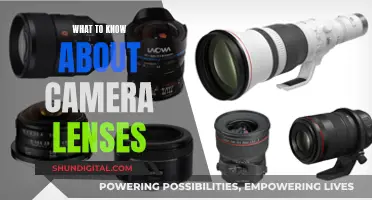
Camera lenses are stamped with a variety of numbers, letters, and symbols that indicate the lens's specifications. These markings can be confusing, especially for beginners, but they are important for understanding what the lens is capable of and what types of photography it is suitable for. The most common markings include focal length, aperture, lens mount system, lens diameter, focusing distance, and image stabilization. Other specifications, such as the autofocus system and premium lens classifications, can also be denoted through a combination of letters and numbers. Understanding these markings is crucial for making an informed choice when purchasing a lens and for utilising the lens effectively in various photographic situations.
What You'll Learn

F-Numbers and aperture
The f-number, also known as the f-stop, is a measure of the light-gathering ability of a camera lens. It is calculated by dividing the focal length of the lens by the diameter of the aperture. The f-number is usually expressed using the format f/N, where N is the f-number. For example, an f-number of f/2 means the focal length of the lens is twice the size of the aperture.
The f-number is a crucial concept in photography as it determines the depth of field, diffraction, and exposure of a photograph. A lower f-number means a larger aperture and more light entering the system, resulting in a brighter photograph. Conversely, a higher f-number means a smaller aperture and less light entering the system, leading to a darker image.
When working with the f-number, it's important to understand its impact on exposure. Changing the f-number affects the depth of field and the amount of light that reaches the camera sensor. Each increase or decrease in f-stop represents a doubling or halving of the amount of light entering the camera. For instance, f/2.0 indicates a wider aperture than f/4.0.
The size of the aperture, represented by the f-number, also influences the depth of field. A wider aperture, denoted by a smaller f-stop number (e.g. f/1.8), results in a shallow depth of field, with only a small portion of the image in focus. On the other hand, a narrower aperture, represented by a larger f-stop number (e.g. f/16), produces a deeper depth of field, bringing more of the scene into focus.
Additionally, the aperture size affects the occurrence of aberrations, which are imperfections caused by the lens. Large apertures (small f-numbers) are more prone to spherical aberrations, causing a softening of the image, while small apertures (large f-numbers) can lead to chromatic aberrations that create colour fringing.
In summary, understanding the f-number and its impact on aperture is vital for photographers as it directly influences exposure, depth of field, and the overall look of images. By carefully adjusting the f-number, photographers can create stunning and well-balanced photographs.
Sigma Lenses: Compatible with Full-Frame Cameras?
You may want to see also

Focal length
Lens focal length determines the angle of view (how much of the scene will be captured) and the magnification (how large individual elements will be). The longer the focal length, the narrower the angle of view and the higher the magnification. Conversely, the shorter the focal length, the wider the angle of view and the lower the magnification.
There are two types of lenses: prime and zoom. Prime lenses have a fixed focal length, meaning the perspective of the image can only be changed by physically moving the camera closer to or further from the subject. Zoom lenses, on the other hand, have variable focal lengths, allowing for more flexibility in framing a scene without having to move the camera.
The focal length of a lens also determines whether it is considered a wide-angle, standard, or telephoto lens. Wide-angle lenses have a focal length up to around 35mm and offer a wider field of view than the human eye, making them ideal for landscape photography and large group portraits. Standard lenses have a focal length of around 50mm and are said to provide a "natural perspective" similar to that of the human eye. Telephoto lenses have a focal length of 85mm or more and produce a more tightly framed view, making them suitable for photographing distant subjects such as in wildlife or sports photography.
When choosing a lens, it is important to consider the focal length to ensure it is suitable for the type of photography you intend to do. Prime lenses tend to offer larger maximum apertures, making them advantageous in low-light conditions, while zoom lenses provide the convenience of multiple focal lengths in a single lens.
Lens Compatibility: Understanding Camera Lens Interchangeability
You may want to see also

Lens diameter
The lens diameter is the physical measurement of the diameter of the front-most part of the lens. It is different from focal length and aperture. The diameter is often marked on the lens using the symbol "ø" followed by a number (e.g., ø52 for 52mm). Common DSLR lens diameters include sizes like 43mm, 49mm, 52mm, 44mm, 58mm, 62mm, 68mm, 72mm, and 77mm.
If the lens diameter is not marked, you can measure the widest part of the lens or refer to the lens specifications. It is important to know the lens diameter when purchasing lens filters because if the filter's diameter doesn't match the lens diameter, it won't screw properly onto the front of the lens.
While there is no set standard for lens diameter size, it does matter in the sense that it is an important part of the optical design of a lens. The larger the opening, the more light that can enter, and the larger the lens elements that can be used internally. Wide-angle and telephoto lenses tend to have larger lens diameters.
Understanding Cameras: Convergent Lenses and Their Uses
You may want to see also

Focusing distance
The focusing distance is usually marked in two scales, feet and meters. These indicate the distance at which the lens is currently focused. At one end of the scale, you will find the infinity symbol, and at the other end, the lens's minimum focusing distance (i.e. the closest the lens can focus).
The minimum focusing distance is the shortest distance from the focusing plane to the subject at which the subject can be sharply rendered, or "in focus". If the camera is moved closer to the subject than the minimum focusing distance, it will not be possible to focus on it.
On a zoom lens, the focusing distance may be a range of numbers. For example, a reading of 0.5m / 1.64ft – 0.8m / 2.63ft means that as the lens zooms in, the minimum focusing distance increases. At the widest focal length, the focusing distance is 0.5 meters, but when zoomed in, the focusing distance is 0.8 meters.
Camera Lenses: Sales, Deals, and Discounts
You may want to see also

Image stabilisation
There are two types of image stabilisation: lens-based and in-camera. Lens-based stabilisation uses a floating lens element that is electronically controlled and shifted in the opposite direction to any camera shake recorded by the camera. In-camera systems work in a similar way, but physically shift the image sensor to compensate for the camera's movements.
Lens-based stabilisation tends to perform more smoothly when using longer focal length lenses, but it is not available as an option for all lenses and it adds to the cost. In-camera stabilisation, on the other hand, works with any lens you can mount on the camera and is considerably less expensive. However, it is less effective when shooting with longer focal length optics.
Manufacturers have different names for image stabilisation, but the most common acronyms include:
- Image Stabilisation (IS) – Canon
- Vibration Reduction (VR) – Nikon
- Optical SteadyShot (OSS) – Sony
- Optical Image Stabilisation (OIS) – Fujifilm
- Image Stabilisation (IS) – Olympus
- Optical Stabilisation (OS) – Sigma
Cameras and Lenses: Capturing the 3D World
You may want to see also
Frequently asked questions
The numbers on a camera lens refer to the focal length and aperture range. The lower the focal length, the more you will see in your image (wider view). The higher the focal length, the less you will see in your image (more zoomed in). The smaller the aperture number, the wider the aperture and the more light gets into your camera.
A prime lens has a fixed focal length, meaning there is no zoom function. A zoom lens has a variable focal length with a minimum and maximum focal length.
The "F" on a lens stands for f-stop or f-number and relates to the "speed" of the lens. The size of the aperture is denoted by an "f" followed by a "/" and then a number, e.g. f/4.5.
The diameter of a lens is represented by the symbol Ø followed by a number, which indicates the measurement in millimetres. For example, Ø72 means the lens diameter is 72mm.







